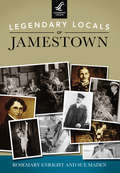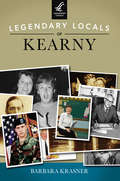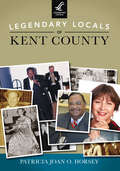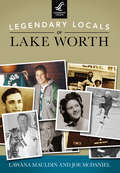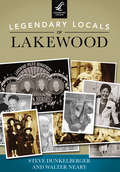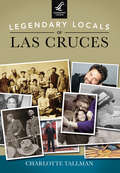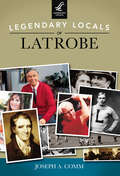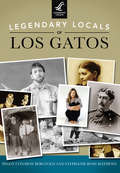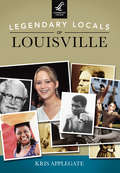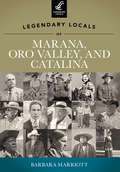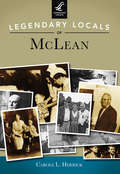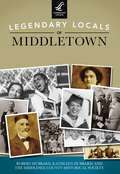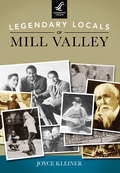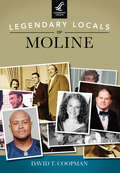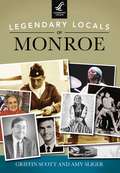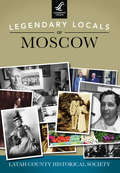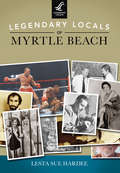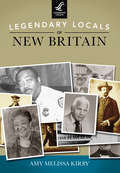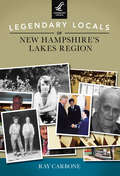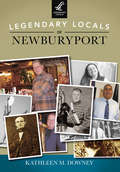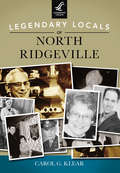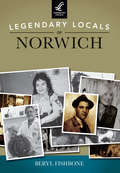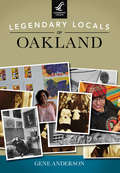- Table View
- List View
Legendary Locals of Jamestown
by Sue Maden Rosemary EnrightWhen Caleb Carr, one of the 101 men who purchased Conanicut and Dutch Islands in 1657, petitioned the General Assembly to incorporate Jamestown in 1678, the town had 150 inhabitants. The community thrived until the American Revolution, when the British occupation drove away many people. Nicholas Carr and John Eldred both remained, rebelling in their own ways. The town recovered slowly, and its character changed with modernized modes of transportation. Steam ferries, introduced in 1873, ushered in an era of resort hotels, affluent summer visitors, and a service economy. The West Passage bridge in 1940 brought permanent residents with off-island occupations and interests. The East Passage bridge (1969) and the replacement West Passage bridge (1992) created a suburban atmosphere enlivened by a continuing influx of summer vacationers. Most newcomers revel in the island's beauty and are intent on keeping Jamestown the peaceful haven that attracted them.
Legendary Locals of Kearny
by Barbara KrasnerHeroes lead, inspire, and perform memorable acts that shape the lives of others. In the pages of this book, readers will learn the stories behind Kearny's heroes--the people whose contributions made Kearny into the thriving, diverse community it is today. Ed Karolasz gave his life for his country during the war in Iraq. Councilman Norman Doyle helped a young girl get the medical attention she needed. College student Gabriela Salvador restores historic costumes for the town museum. Real estate developers Louis Lindblom and Edward Strong built the town's financial institutions and the Arlington section. Educators Peg Bixler and Barbara Toczko devoted themselves to their students. From the town known as Soccertown, USA, came John Harkes, Tony Meola, and Tab Ramos, who played on the United States team in the FIFA World Cup. But there was also Louis Eilshemius, the somewhat mad and reclusive artist, and Albert Gonzalez, a government informant and computer criminal. This "City of Opportunity" has produced more than its share of personalities that have created admirable and notorious international, national, and local legends.
Legendary Locals of Kent County
by Patricia Joan HorseyKent County, located on the Eastern Shore of the Chesapeake Bay, is noted for its farms, outdoor recreation, architecture, and its people. Legendary Locals of Kent County recognizes only a handful of the many Kent County people who deserve to be noted. Included are Tony Award-winning Mark Bramble, who is a director, author, and producer; controversial and colorful Evelyn Harris, also known as the "Barter Lady," who gained fame during the Depression when she proposed a system of swapping to overcome the shortage of money; elected official, school principal, minister, and artist Clarence Hawkins; Sheriff Bartus O. Vickers, who earned the respect of prisoners, lawyers, other law enforcement officers, and citizens; game warden Bozy Robinson, friend of both the hunter and the hunted; and writer Gilbert Byron, who detailed life on the Chesapeake Bay throughout the 20th century.
Legendary Locals of Lake Forest (Legendary Locals)
by Arthur H. Miller Susan L. KelseySince the 1850s, Lake Forest, located 30 miles north of Chicago on Lake Michigan, has been a distinctive suburb. It has been a retreat from the diseases, public accessibility, rougher elements, soot, stockyard smells, and general density of bustling city life. For at least five generations, it has been the retreat for Chicago's leading New England-descended families, such as the Farwells, Swifts, and Armours. And for over 150 years, Lake Forest has been the home for a community of educators, merchants, artisans, designers, and a wide variety of estate specialists, the latter from pre-Civil War escaped slaves and Scots and Irish immigrants to today's notable garden and interior artists. Legendary Locals of Lake Forest draws on rare archival images from local and Chicago public and private sources.
Legendary Locals of Lake Worth (Legendary Locals)
by Lawana Mauldin Joe McdanielDuring the early 1900s, a large reservoir built to provide water for Fort Worth, Texas, also opened up opportunities for businesses to develop. Casino Beach, Casino Ballroom, and a large bathhouse became popular spots for thousands. A nearby village, with increasing population, soon had a small school, churches, and other establishments. With nearby Jacksboro Highway running from downtown Fort Worth past the beach area, gambling increased, as did gangster activity. After a long while, with much intervention, these unlawful situations became history. Legendary Locals of Lake Worth spotlights the founders of the small village and features individuals who impacted the area--many for the better, others for the worst. Some may never have received proper recognition until this book's acknowledgment of them.
Legendary Locals of Lakewood (Legendary Locals)
by Walter Neary Steve DunkelbergerLakewood was a vibrant community long before it incorporated in 1996, though cityhood helped give the area one name and identity. In the mid-19th century, Lakewood was the site of British farms and the first US military base in Washington Territory. Men who became famous in the Civil War, such as George Pickett, served there. Native American leader Leschi, the victim of "judicial lynching" by civilians, spent his last days there. As Lakewood became a retreat for Puget Sound's rich and famous, names such as Carman and Alexander--as famous in their day as the name Weyerhaeuser was and is--settled here, leaving behind reminders like Lakewold Gardens. One of Lakewood's most famous residents was Ivan, a captive gorilla who captured the hearts of animal lovers worldwide.
Legendary Locals of Las Cruces
by Charlotte TallmanWhen Las Cruces was founded 164 years ago near a group of crosses marking the graves of travelers and soldiers, a rawhide rope separated acreage for a church, a cemetery, and family lots. That rawhide rope brought to Las Cruces a new era filled with the exhilaration of the Wild West and the people who molded "the City of the Crosses." Over the decades, the number of local men, women, and children who deserve recognition as heroes of history or champions of the present is infinite, including Dr. Nathan E. Boyd, entrepreneurial creator of the Boyd Sanitarium; Gov. Susana Martinez, the first female governor of New Mexico and the first female Hispanic governor in the United States; and Letticia Martinez, a legally blind swimmer who competed with the 2012 London Paralympics Swimming Team. Like thousands of others, theirs is a story of persistent hope, courage, and desire to make a difference.
Legendary Locals of Latrobe
by Joseph A. CommLocated at the base of the rolling hills of the Laurel Highlands, Latrobe is best known as the birthplace of children's television pioneer Fred Rogers and golf legend Arnold Palmer. It is the home of Rolling Rock Beer, Pittsburgh Steelers training camp, and St. Vincent College. Latrobe has also been recognized for many famous firsts, like the first banana split, first all-professional football team, first Benedictine monastery in the United States, first nonstop airmail pickup, and first female nuclear scientist at Westinghouse Electric Company. It is a community of individuals who collectively exemplify the strong, hardworking culture of Western Pennsylvania--people like Oliver Barnes, a railroad engineer and Latrobe's founder; Philip Mowry McKenna, innovator in the machining of steel and father of "Kennametal" tools; Joseph E. Greubel, who transformed his family's ice cream-centered dairy stores into the thriving Valley Dairy Restaurants; Dr. Sara Carr McComb, a "legendary" librarian; and Robert Mendler, a Holocaust survivor who spent his life educating young people to respect one other. Legendary Locals of Latrobe celebrates these and nearly 200 other noteworthy figures and groups who have shaped and continue to shape the community.
Legendary Locals of Los Gatos
by Stephanie Ross Mathews Peggy Conaway BergtoldIn 1878, Charles Erskine Scott Wood, builder of the Cats Estate, wrote "Good citizens are the riches of a city." From its beginning, Los Gatos has suffered no shortage of hardworking, inventive, entrepreneurial, and gifted people. Early orchardists found the land unbelievably productive, but their crops were threatened with disease and pesky infestations of gophers. John Bean and Zephyr Macabee provided solutions. Louise Van Meter was an unconventional teacher who championed the new concept of kindergarten. Neta Snook Southern defied traditional female roles to become a pilot. She taught Amelia Earhart to fly before retiring to Los Gatos, where she raised prunes, apricots, and miniature horses. John Steinbeck wrote The Grapes of Wrath during one long, hot summer in town. Steve Wozniak settled in Los Gatos and donated computers to schools. The lives presented here have contributed to the sparkling legacy of the "Gem City of the Foothills."
Legendary Locals of Louisville
by Kris ApplegateDespite humble beginnings on Corn Island in 1778, the city of Louisville has grown to legendary status. Courageous individuals have worked together overcoming hardships, defeating enemies, celebrating victories, and laying the foundation for our river city. Louisville is the home of many legends including boxing great Muhammad Ali, William Clark (of the famed Lewis and Clark Expedition), baseball star Pee Wee Reece, Academy Award-winner Jennifer Lawrence, Pulitzer Prize-winner Marsha Norman, broadcast journalist Diane Sawyer, sculptor Ed Hamilton, and author Hunter S. Thompson. Other legends who have called Louisville home include Kentucky Fried Chicken founder Colonel Harland Sanders, actor Tom Cruise, and inventor Thomas Edison. Louisville boasts the nation's largest annual fireworks display, the world's largest baseball bat, and "The Most Exciting Two Minutes in Sports" also known as the Kentucky Derby. You are invited to read about these and more exceptional folks who have shaped our eclectic city called Louisville.
Legendary Locals of Marana, Oro Valley, and Catalina
by Barbara MarriottRunning west to east along the northern boundary of Tucson is a corridor. of unique and inspiring communities. In Legendary Locals of Marana, Oro Valley, and Catalina, readers will discover the historical riches, courage, and determination of the Western spirit that shaped the state and the country. George Pusch was a member of the Arizona Territorial Legislature that guided Arizona from territory to statehood. Sam Chu, a Chinese immigrant, turned barren land into one of the most productive cotton farms in America. Sheriff John Nelson helped establish Arizona's reputation as cattle country. Under the guidance of Dick Eggerding, the public arts program made Oro Valley one of the best small towns in America. America's talented athletes have called the corridor home, including Hank Leiber, 1930s baseball star; Maren Seidler, Olympic shot-putter; and Sherry Cervi, barrel racing champion. In these communities, charity work, artistic talent, and military courage are found in abundance. If people make history, then the corridor is a treasure trove of the country's past and future.
Legendary Locals of McLean
by Carole L. HerrickMcLean, Virginia, a whistle stop along the Great Falls & Old Dominion Railroad, came about in 1910. It was named after John R. McLean, publisher of the Washington Post newspaper and an owner of the railroad. This was a farming community that never incorporated. A few of the families instrumental in the formation of the village that followed were Mackall, Laughlin, Storm, Carper, and Smoot. Because of its proximity to the nation's capital, McLean attracted people from all walks of life. But it was the arrival of the Kennedy families in the late 1950s that put McLean on the map. The thread that holds the community together is spirited volunteerism. This volume contains images of a few of the personalities who give McLean a sense of place. The majority of the photographs have been donated by individuals to ensure that history does not lose these significant personalities, past or present, who left an imprint on their community.
Legendary Locals of Middletown
by Kathleen Hubbard Robert Hubbard Middlesex County Historical SocietyAlthough the town benefits from a position on a major navigable waterway, Middletown's success is primarily due to the energy, creativity, and diversity of its people. These include James Riley, whose autobiography detailing his trials as a white slave in Northern Africa showed millions of Americans the evils of slavery; Max Corvo, who helped the World War II Italian underground defeat the fascist regime; and Christie Ellen McLeod, longtime chief pathologist at Middlesex Memorial Hospital. Middletown can boast of athletes such as Helen "Babe" Carlson, a tremendously strong competitor who participated on men's baseball teams; Willie Pep, who, while going for the world featherweight title, had a record of 134 wins and only one loss; and Corny Thompson, who sparked the University of Connecticut basketball program's rise to national prominence. More notables include Allie Wrubel, a prolific songwriter and Academy Award winner for his song "Zip-A-Dee-Doo-Dah;" Vivian McRae Wesley, a teacher, reading director, and leader of Middletown's African American community; and Francesco Lentini, who was born with three legs and appeared in every major circus and carnival.
Legendary Locals of Mill Valley
by Joyce KleinerSince the 1800s, Mill Valley has attracted spirited freethinkers, entrepreneurs, nature lovers, rabble-rousers, and more than a few rock stars. Early Mill Valley booster Sidney Cushing encouraged tourism with a train up Mount Tamalpais called "the Crookedest Railroad in the World." Laura White, more concerned with protecting Mill Valley's natural beauty than attracting more people, brought the town its "Outdoor Art Club" and a tradition of conservationism. Vera Schultz broke the glass ceiling of local politics in 1946, and in 1973, 10-year-old Jenny Fulle's letter to President Nixon changed the future of America's female athletes. When an elementary school teacher named Rita Abrams wrote a song about why she loved Mill Valley, it became a national hit; so did a song about the heart of rock and roll, written by local boy Huey Lewis, who had attended that same school. The stories of Mill Valley's legendary locals--whether from 1890 or 1980--are sometimes heartbreaking, sometimes inspiring, often humorous, and always fascinating.
Legendary Locals of Moline (Legendary Locals)
by David T. CoopmanDavid Benton Sears could be considered the father of Moline, Illinois. It was upon his land that Moline was platted in 1843. It was because of his brush dam on the Mississippi River between the Moline shore and Rock Island--known today as Arsenal Island--that significant industry began to develop. Grain and lumber mills were the first, but farm implement and related factories soon found prominence after John Deere moved his plow-making business here in 1848. It would not be long before immigrants, particularly the Swedish, Belgian, and German, were drawn to Moline for the jobs and opportunities and added to the growing and prosperous population. Legendary Locals of Moline tells the known and not-so-well-known stories of many of the early and the more-recent individuals who have contributed to the fabric of the community, both locally and nationally. Historical and current photographs illustrate those who affected business and industry, culture, academia, public service, organizations and philanthropies, and sports and entertainment.
Legendary Locals of Monroe
by Amy Sliger Griffin ScottLocated at the center of the 12 rural parishes that comprise northeastern Louisiana, Monroe has long been a tiny metropolis offering its citizens a taste of the colorful politics and rich cultural history for which the Bayou State is known. Featuring the tales of the area's most prominent politicians, innovators, entrepreneurs, broadcasters, musicians, reality stars, athletes, educators, movers, shakers, and rabble-rousers, Legendary Locals of Monroe takes a look at the characters whose fascinating stories paint the vibrant history of this southern river city. Presented in a clear, concise format, this volume features biographical accounts that range from inspiring and captivating to shocking and tragic. Profiles include such notable locals as indie-film queen Parker Posey, Coca-Cola innovator Joseph Biedenharn, pizza restaurant dynamo Johnny Huntsman, Black Panther Party founder Huey P. Newton, baseball great Chuck Finley, country music superstar Andy Griggs, internationally renowned composer Frank Ticheli, flamboyant politician Shady Wall, and many more.
Legendary Locals of Moscow
by Latah County Historical SocietyThe rich and fertile land upon which Moscow sits has sustained a vibrant community of hard working thinkers, creators, and activists for more than 125 years. Just as the area's first inhabitants returned to camas fields in Paradise Valley year after year, pioneers settled in "Hog Heaven" because they found ready access to life's necessities. Businessmen like Nathaniel Williamson and Frank David tied their fortunes to the local farming economy to the same degree as seed pioneer Willis Crites or sustainability advocate Mary Jane Butters. While the bounty that surrounds Moscow feeds its growth, the town's cultural lifeblood is pumped by the University of Idaho. The university has provided Moscow with inventors such as Malcolm Renfrew, talented athletes like Olympian Dan O'Brien, and colorful characters, perhaps best embodied by Dean of Women Permeal French. The picturesque hills of the Palouse roll through the history of this unique town, rooting tomorrow's leaders in the work of yesterday's groundbreakers.
Legendary Locals of Myrtle Beach
by Lesta Sue HardeeSimeon B. Chapin was an entrepreneur and visionary who, along with Franklin G. Burroughs, helped create the foundation of what is Myrtle Beach today. B.B. Benfield built and opened the area's first movie theater, and Lawrence Boulier was a landscape artist and founder of the Waccamaw Arts and Crafts Guild. John Woodside built the grand Ocean Forest Hotel. Col. H.B. Springs was the town's first insurance and real estate agent, and James Bryan Sr. was the first president of Myrtle Beach Farms. Blanche Floyd was a beloved teacher and author, and W.L. Harrelson made history by serving as Myrtle Beach's first mayor. Earl Husted brought the first amusement park rides to this area, and Anthony James left after high school to make a name for himself as the first widely known actor from the Myrtle Beach area. The stories of these Myrtle Beach notables and many more fill the pages of this book. Some of these names may be unfamiliar, but each of these legendary locals, in his or her own way, has helped make Myrtle Beach the historical hometown and vacationers' paradise that it is today.
Legendary Locals of New Britain (Legendary Locals)
by Amy Melissa KirbyNew Britain began in 1754 as an ecclesiastical society and farming village, and with few natural resources, was transformed into a modern industrial city by the time of its incorporation in 1871. Attracting waves of immigrant workers and entrepreneurs, this became a diverse but unified community in which people of all ethnicities worked together, served together in times of war, and even played together on the baseball fields. Legendary Locals of New Britain includes remarkable residents among the early inhabitants and settlers; the people and institutions that brought New Britain to cityhood; artists and entertainers; famous or leading immigrants; sports legends; and men and women who have otherwise made their mark on New Britain, the nation, or the world.
Legendary Locals of New Hampshire's Lakes Region (Legendary Locals)
by Ray CarboneThere are few places in America that have such a rich variety of landscape and scenery as the Lakes Region of New Hampshire: from the summer calm of Squam Lake to the robust white winter mountaintops of the Gunstock Mountain Resort. So it is no surprise that the people who call it home reflect the same wide palette of humankind--from the pre-Revolutionary War surveyors who first marked their initials on a rock at Weirs Beach to Bob Lawton, the current owner of the world's largest arcade; from one of George Washington's inner circle to Ernest Thompson, the award-winning author of On Golden Pond. The Lakes Region draws them--or grows them--all, because it has it all.
Legendary Locals of Newburyport
by Kathleen M. DowneyYeat! The colloquial greeting is distinctly Newburyport, uttered by this seaport's citizens to acknowledge one another in passing or to seek out fellow locals in far-flung places. Individuals featured in Legendary Locals of Newburyport extend to readers a congenial "Yeat!" William Lloyd Garrison, native son and leading abolitionist; "Lord" Timothy Dexter, who staged his own mock funeral; Harry O'Connor, founder of the World's Shortest St. Patrick's Day Parade; James Stehlin, celebrated Newburyport High School football coach; Rhina Espaillat, award-winning poet and founder of Powwow River Poets; Richard Simkins, owner of the legendary Grog restaurant-tavern; Sue Little, owner of Jabberwocky Bookshop; Tom Maginnis, drummer for the post-punk band Buffalo Tom; Mickey, feral cat mascot for the Merrimack River Feline Rescue Society, and 1st Lt. Derek Hines, who gave his life while serving his country in Afghanistan, are among the legendary locals--native born and transplants--who have left their imprint, or paw print, upon the Port.
Legendary Locals of Norco (Legendary Locals)
by Kevin BashFrom its beginning as a poultry powerhouse to World War II Navy town and to Horse Town USA, Norco has been known over time as a community of go-getters and dreamers with unparalleled volunteerism, stubbornly protecting a rural way of life. Founder Rex Clark wished for families to be self-sustaining with what they could grow and raise on their property; wounded Marine Johnny Winterholler, against incredible odds, led the way for other disabled veterans as the star of the famed wheelchair basketball team the Rolling Devils; and Tamara Ivie fulfilled her impossible dream to play professional baseball. And regular folks, known once as "Acres of Neighbors," stepped up to create a city of "elbow room," stopping cold, big-money developers wishing to cut the community into small lots. Today, Norco is an equestrian paradise with trails on most streets and plentiful open space. For decades, this small community has produced activists, ballplayers, college presidents, physicians, actors, cowboys, and lots of Norconians who give back to the community that raised them.
Legendary Locals of North Ridgeville
by Carol G. KlearIt was 1810 when a group of men from Connecticut roved west to Ohio, establishing the first permanent settlement in what became North Ridgeville. Led by David Beebe Sr., they foraged for food and shelter. The pioneer spirit of the aggregation sustained them and others who followed. Farming provided sustenance and many farms including those owned by the Solomons, Gerharts, and others have continued the tradition. Education was greatly respected and 10 school districts became part of the community's landscape. An early school still stands on Jaycox Road, where retired teachers Julie Bajda and Barb Sutton reenacted the roles of teachers from earlier times. The former Buffalo Trail became Center Ridge Road, the city's main thoroughfare, and, in 1960, the township developed into a city governed by a mayor, council, and various department heads. Businesses, such as Buescher's Hardware and the Bogner Funeral Home opened and remain today. Groups of residents cultivated interests into organizations with a goal of working together seamlessly for the good of the community.
Legendary Locals of Norwich
by Beryl FishboneNorwich measured nine square miles in the 1659 deed that Mohegan chief Uncas gave to the brave English settlers from Old Saybrook. The names of the city's streets and parks are testaments of the pride the community has in its town's residents and history. Stories abound of Norwich natives and American revolutionaries like John Durkee, who made the king's tax representative resign; scoundrel Maj. John Mason, who ordered the Mystic massacre of 100 men; and traitor Benedict Arnold, who burned the nearby city of New London. Legendary Locals of Norwich also sheds light on Norwich's more modern heroes and heroines, whose everyday actions give homage to the past, recognition to the present, and courage and vision to the future. Featured are Stanley Israelite, whose personal drive has helped businesses and individuals succeed; Eileen Akers, whose actions changed the world for students; the philanthropy of Harold Ross; and the pride of retailer Jackie Quercia.
Legendary Locals of Oakland
by Gene AndersonOakland has been shaped by the transcontinental railroad, freeways, earthquakes, and its location on the shores of San Francisco Bay. But what makes Oakland such an amazing city are the people who have called Oakland home over the years, like Mayor Samuel Merritt, who helped make Oakland the terminus of the transcontinental railroad; Elizabeth Flood, who worked to desegregate Oakland schools in the 1870s; and F.M. "Borax" Smith, who created the Key System. Oakland has been home to game-changing athletes like "father of modern tennis" Don Budge and Curt Flood, who helped bring free agency to sports; artists like writer Jack London, dancer Isadora Duncan, poet Joaquin Miller, and cartoonist Morrie Turner; and culture-shaping movements like the Black Panther Party. However, the impact of Oaklanders is not just historical. From Oscar Grant to Favianna Rodriguez to Marshawn Lynch to Jerry Brown, people in Oakland continue to shape not just "the Town," but the entire country.
